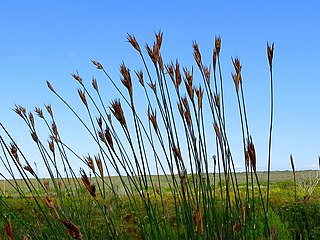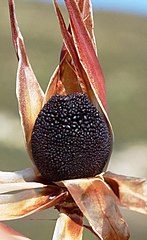Biology:Ceratocaryum argenteum
| Silver arrowreed | |
|---|---|

| |
| Scientific classification | |
| Kingdom: | Plantae |
| Clade: | Tracheophytes |
| Clade: | Angiosperms |
| Clade: | Monocots |
| Clade: | Commelinids |
| Order: | Poales |
| Family: | Restionaceae |
| Genus: | Ceratocaryum |
| Species: | C. argenteum
|
| Binomial name | |
| Ceratocaryum argenteum Nees ex Kunth
| |

| |
| Distribution of Ceratocaryum argenteum | |
| Synonyms[1] | |
| |
Ceratocaryum argenteum, commonly known as silver arrowreed, is a species of plant in the Restionaceae family and is native to the Cape Provinces of South Africa .[1]
Description
The caespitose plants are 2–3 metres ([convert: unknown unit]) tall and grow in coastal sands at elevations of 50–200 metres (160–660 ft) above sea level. They flower throughout April and May. The plants release their tuberculate nut fruits in January.[2][3]
Ecology
Ceratocaryum argenteum has an unusual seed dispersal strategy. It employs chemical compounds to deceive dung beetles, which treat the seeds as if they were true animal fecal matter. The beetles bury the seeds.[4] This strategy of faecal mimicry is shared with another species, namely Ceratocaryum pulchrum.[2] The seeds are not consumed or gathered by rodents.[5] Their strategy of adaption to wildfires is to re-grow from seeds after such fires occur.[3]
Ceratocaryum argenteum. The seeds resemble dung balls in great detail and deceive dung beetles. This is called mimicry.
Distribution
This species is native to the southwestern Cape Provinces of South Africa, from Albertinia to Paarl.[1]
Taxonomy
It is the sister species of Ceratocaryum pulchrum.[2]
References
- ↑ 1.0 1.1 1.2 "Ceratocaryum argenteum Nees ex Kunth" (in en). Royal Botanic Gardens, Kew. http://www.plantsoftheworldonline.org/taxon/715769-1. Retrieved 5 July 2022.
- ↑ 2.0 2.1 2.2 Midgley, J. J., White, J. D. M., Scholtz, C. H., & Johnson, S. D. (2021). "Seed dispersal by dung beetles in Ceratocaryum pulchrum (Restionaceae): Another example of faecal mimicry in plants." South African Journal of Botany, 137, 365-368.
- ↑ 3.0 3.1 Linder, H. P. (2001). "Two new species of Ceratocaryum (Restionaceae)." Kew Bulletin, 465-477.
- ↑ Midgley, J. J., White, J. D., Johnson, S. D., & Bronner, G. N. (2015). "Faecal mimicry by seeds ensures dispersal by dung beetles." Nature Plants, 1(10), 1-3.
- ↑ Midgley, J. J., White, J. D., & Bronner, G. N. (2017). "Camera-trapping and seed-labelling reveals widespread granivory and scatter-hoarding of nuts by rodents in the Fynbos Biome." African Zoology, 52(1), 31-41.
Wikidata ☰ Q15512316 entry
 |




